1462 Egyptian Bronze Animal Wall Art 1462 Egyptian Wall Art
What is Zoomorphism?
Zoomorphism is defined as the use of animal forms in fine art. Zoomorphic images tin can be used as subject matter, to carry a narrative or simply as a decorative element. These works oftentimes exhibit animal style or the use of animals in a more than stylized manner. Zoomorphic animal forms are found in paintings, sculpture, decorative arts, textiles, and architecture.
Famous Zoomorphic Art
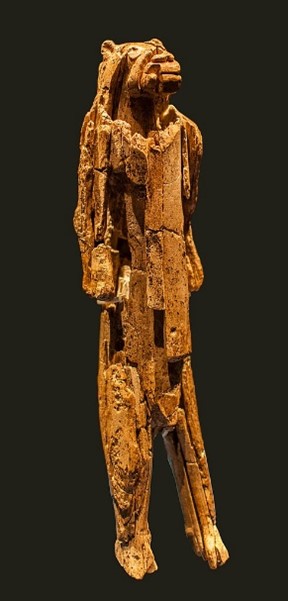
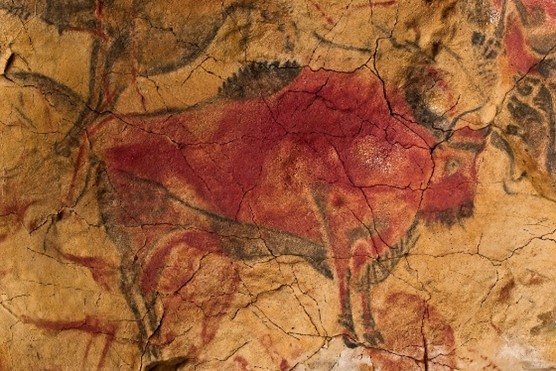
UNESCO World Heritage Center
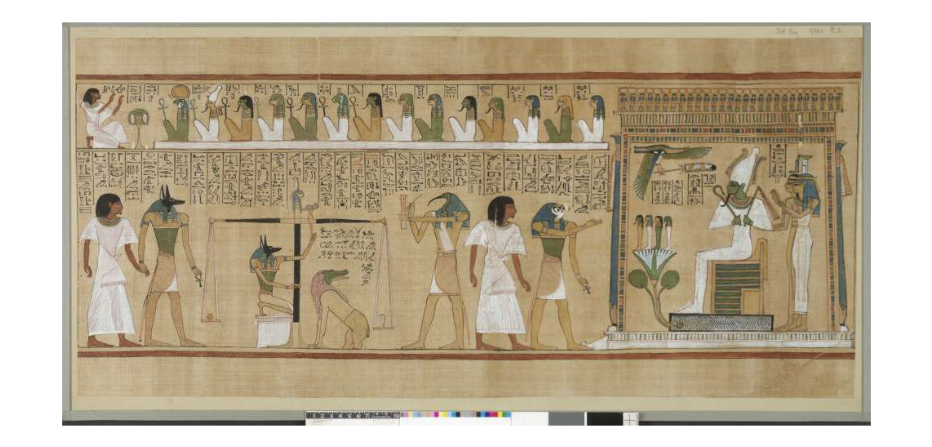
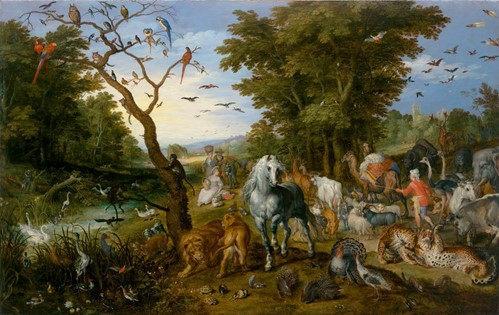
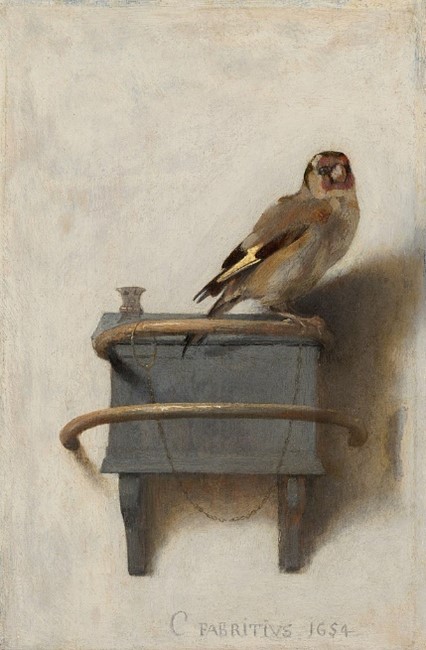
Zoomorphism and Stone Historic period Art
In this nomadic age, humans hunted for birds, bison, elk, deer, and mammoth. These animal forms were part of Stone Age art.
The oldest zoomorphic figure on record is Lion-man, an ivory work found in the German caves of Swabian Jura. The 35,000-year-old artwork is now in the Museum Ulm, in Ulm, Germany. Lion-man has the caput of a lion and the body of a man.
Archeologists from the Department of Prehistory at the German University of Tubingen discovered the first carving to resemble a mammoth, while in Hohlenstein mountain region, in 2006. The piece of work at present called Vogelherd Mammoth is made from ivory and dates to 33,000 BCE.
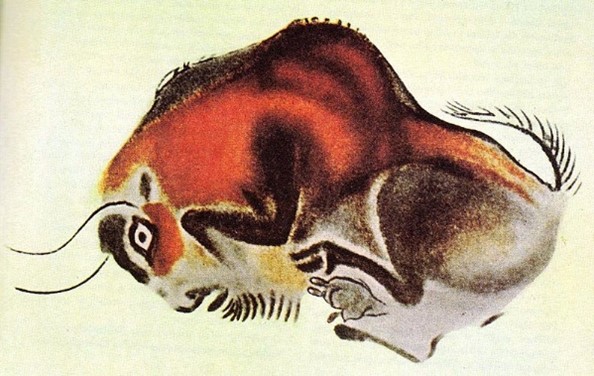
With new technology, archeologists take determined that the zoomorphic paintings on the ceiling of Spain's Altamira Caves are more than 34, 000 years quondam.
Zoomorphism and Ancient Art
In the Last Judgment of Hu-Nefer from The Book of the Dead, dating dorsum to the New Kingdom, 1275 BCE, beast forms play a religious role in the narrative scroll. Hu-Nefer holds the paw of the god Anubis, with the head of a jackal, associated with the afterlife and mummification.
To the right is the fierce Ammit, depicted equally a goddess with the trunk of a lion, the hind legs of a hippopotamus and the face of a crocodile, stands ready to devour those deemed unworthy.
On the other side is Toth, the Egyptian god of writing and wisdom, with the caput of an ibis, who records the name of whoever enters. The god Horus, with the caput of a falcon stands fix to present the human to Osiris, the god of the underworld, who sits on the throne.
Cats were considered demi-deities to the ancient Egyptians and were believed to be descendants of the goddess Bastet (Bast) who brought good health and protection.
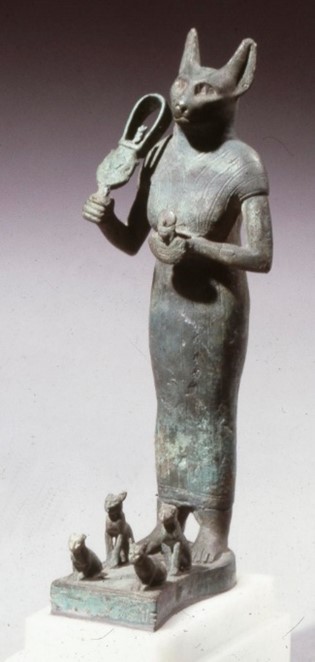
The Statuary figure of Bastet represents the goddess in a long gown, depicted with iv kittens at her feet. The eyes have gilt inlay. The ears of Bastet have piercings, and then this statue would take had earrings. Statuary statues such as these were made to be donated to temples.
The ancient Scythian people were originally from Iran, and as a nomadic group gradually relocated to southern Russia and Ukraine between the 7th and eightthursday centuries BCE. Powerful warriors, they were known for their wealth, through trading with the ancient Greeks. Money was used to purchased gilt made into zoomorphic inspired jewelry, decorative objects, and ornaments, too as boxing weaponry.
Scythian art also, known as Steppes art, featured animate being forms alone and or in groups engaging in battle. Animal forms include birds, domestic animals, horses, deer, stags, lions, and panthers, likewise every bit more fantastical beasts like griffins and sirens.
The Golden Scythian below is a pectoral or necklace. Information technology shows horses being torn apart by griffins on the lower tier.
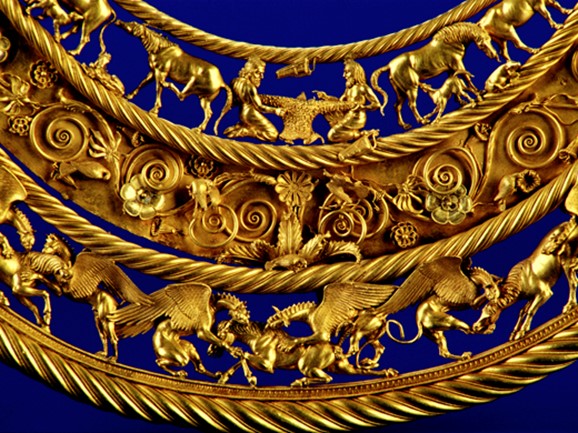
Zoomorphic Fine art in Early Europe
Creature forms in Early on European art were used as symbols or to tell total narratives. Artist used animal forms in scenes of battle, hunting and sport. In Christian fine art birds were thought to represent the soul, while peacocks were a sign of everlasting life due to the belief that their flesh never decayed
In the Medieval Flow, birds, and serpents were mutual creatures in art. Eagles were considered the highest form in the bird kingdom. Dogs symbolized loyalty and lions were a symbol of royalty. Mystical creatures were besides office of zoomorphic art including unicorns, dragons, and griffins.
The Hiberno-Saxon people (the quondam from Republic of ireland and latter German) settled as a community in Britain, where the monastic civilization at the time encouraged works of art such as the Lindisfarne Gospels . The Early Medieval illuminated manuscript, from 700 CE contains texts and images many of which are zoomorphic.
Thick with the shape of snakes, in animal style, the Lindisfarne Gospel uses horror vacui. Translated from Greek this ways "fearfulness of empty space". Every space is filled, and the zoomorphic images make apply of interlacing through the form of complicated twits and knots, the best instance of which is Mathew's carpet page.
A gold belt buckle from the Sutton Hoo Ship Burial, the largest archaeological dig in British history, is rich with zoomorphic pattern. Dating back to the viithursday century Anglo-Saxon community the buckle includes an interlacing shape of snakes, using horror vacui, as well as birds of casualty depicted on assail, in brute style.
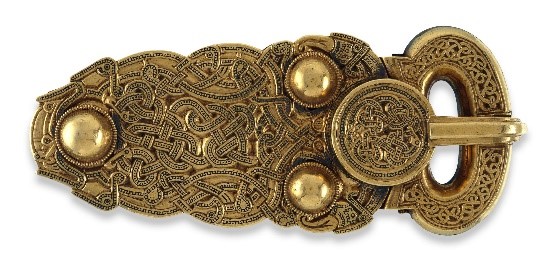
Fauna forms help to conduct a narrative. Piero di Cosimo (1462-1522) painted The Wood Fire based on a poem by Roman philosopher Lecretius. Tree trunks explode and branches burn down every bit creatures both wild and domestic run to escape. A deer and a pig have the heads of satyrs.
The Entry of Animals into Noah's Ark was painted by Flemish artist Jan Brueghel the Elder (1568-1625) in 1613, illustrates a scene from the bible. As courtroom painter to Archduke Albert and Infanta Isabella, who ruled what is Belgium today, he had access to their vast collection of rare animals and birds from which he composed studies.
Information technology was said that a small goldfinch flew over Jesus while fastened to the cantankerous and pulled a thorn from his head. St. John the Baptist shows a goldfinch to Jesus every bit if foreshadowing his future in Raphael'southward (1483–1520) Loftier Renaissance painting Madonna of the Goldfinch (1505-1505).

Dutch painter Carel Fabritius (1622-1654) is best known for his masterpiece, The Goldfinch (1654), a Baroque oil on canvass painting, capturing the minute details of a bird set up to take flight.
Zoomorphic Representation in Islamic Art
The opposition of human and animal depiction, or aniconism, in religious fine art and architecture did not extend to secular artwork in the Muslim world. Here, Islamic art used animal based figural designs in miniature paintings, decorative arts, textiles, and architecture.
The poem Linguistic communication of the Birds (Mantiq al-tair) written by twelfth century Iranian poet Farid al-Din 'Attar (1142–1220 CE) was the inspiration for this illustration, The Concourse of the Birds, on the folio of this sixteenth century Timurid miniature. The folio which shares the same name as the poem was painted by Iranian creative person Habiballah of Sava (1590-1610 CE), in 1600 CE, Language of the Birds uses ink, opaque watercolor, gold and silver on newspaper.
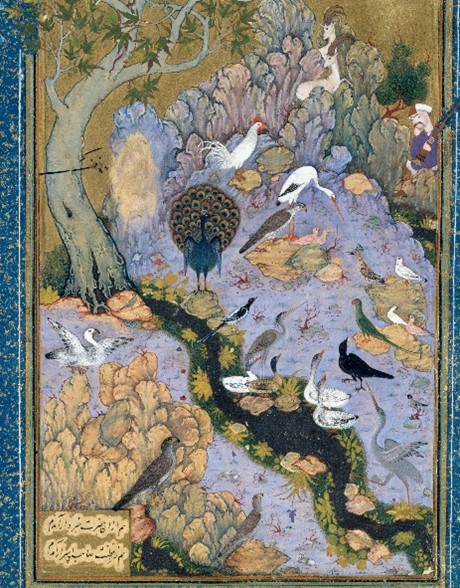
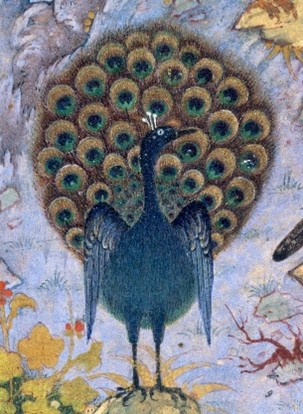
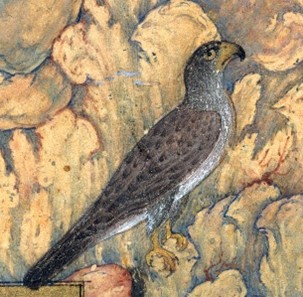
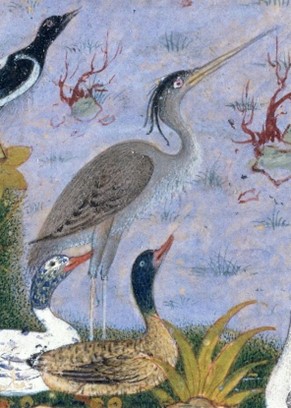
In this Islamic art zoomorphic painting, each bird represents one soul. All are in search of "simurgh" a mystical bird for spiritual unity. Birds along the banks of the river include herons, swans, ducks, doves, a militarist and even a peacock with plumage fully extended. In the distance in the mountains are ii goats with stylized horns. Off to the right is a hunter with an elongated musket.
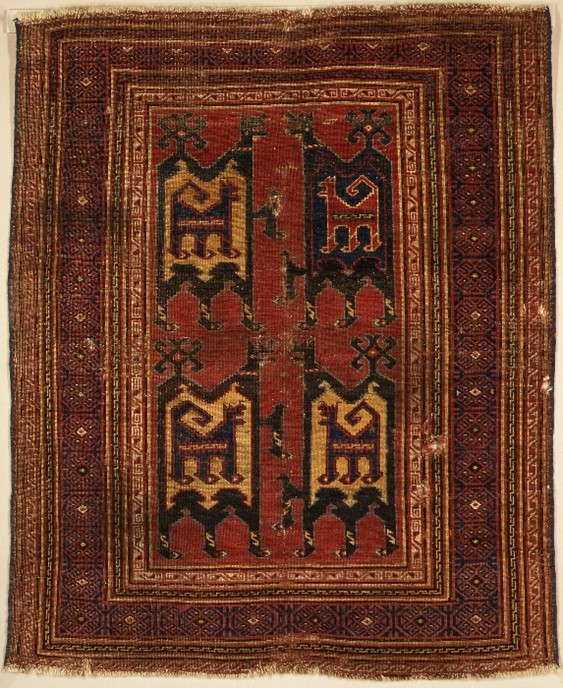
The 14th century Turkish rug, Confronted Beast Rug contains smaller animals inside larger animal forms, in a highly stylized geometric design.
Beast Forms in Contemporary Artworks
American Artist Jeff Koons used the image shape of a dog, in his mirror cease stainless-steel works, with a transparent coating of pigment. These works of zoomorphic art were created in a series called Balloon Canis familiaris (1994-2000), in orangish, blue, magenta, ruddy and yellow.
Pisupo Lua Afe (Corned Beef 2000) by New Zealand born artists Michael Tuffery, is a mixed media work, created in 1994. He used cans from corned beef, which were flattened to create a life-sized bull.
Artists Who Created Zoomorphic Artworks
- Piero di Cosimo (1462-1522 CE) Italian
- Jan Brueghel the Elder (1568-1625 CE) Flemish
- Raphael (1483-1520) Italian
- Carel Fabritius (1622-1654 CE) Dutch
- Habiballah of Sava (1590-1610 CE) Iranian
- Michael Tuffery (1966- ) New Zealand
- Jeff Koons (1955- ) American
Related Fine art Terms
- Animal style
- Aniconism
- Horror vacui
- Interlacing
- Secular art
- Islamic Art
- Meso-American Fine art
Source: https://www.artlex.com/art-terms/z/zoomorphic-art/
0 Response to "1462 Egyptian Bronze Animal Wall Art 1462 Egyptian Wall Art"
Post a Comment